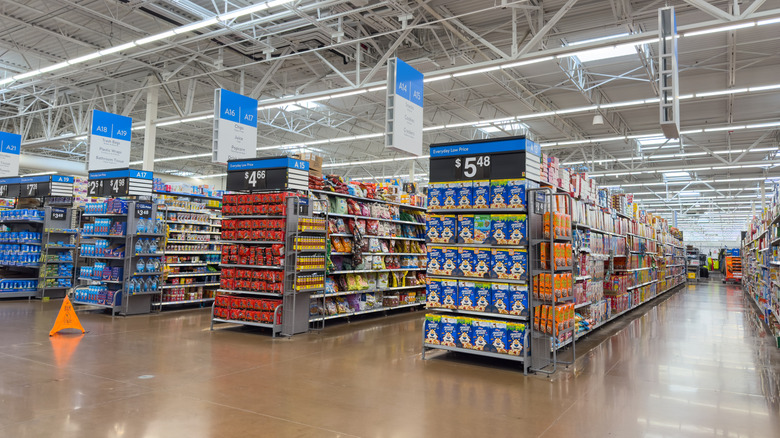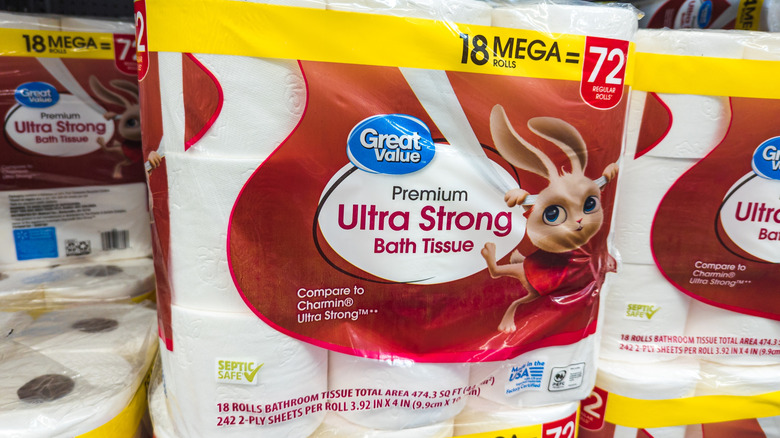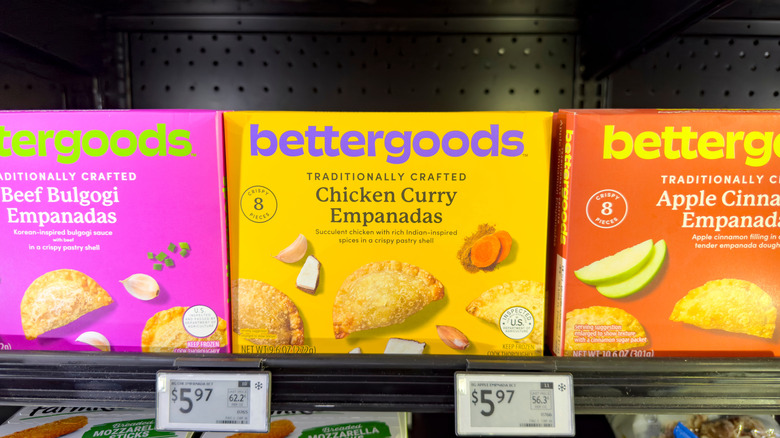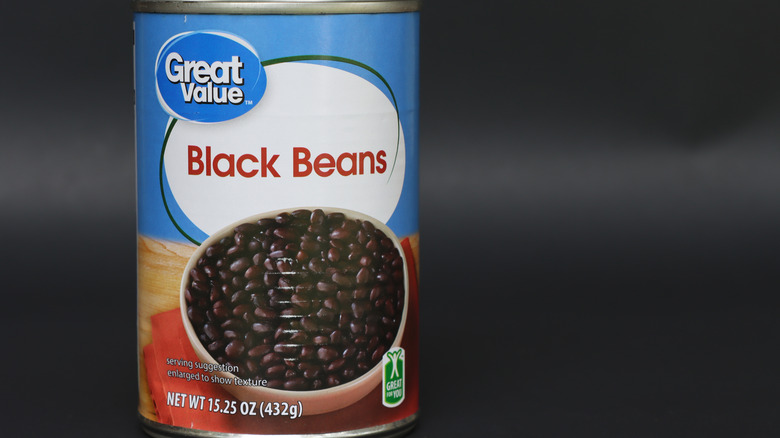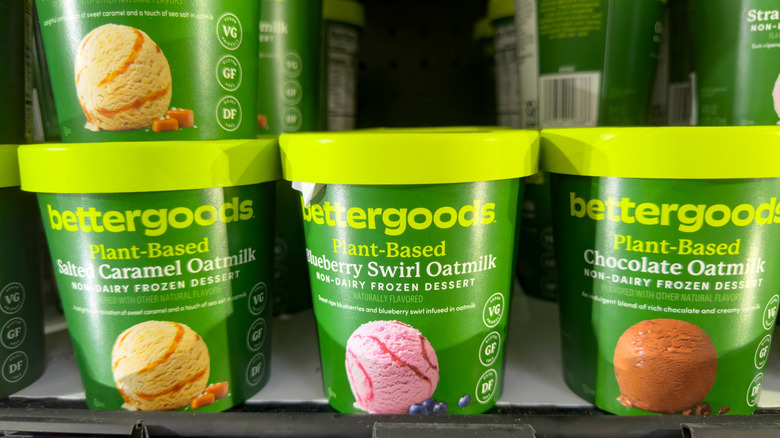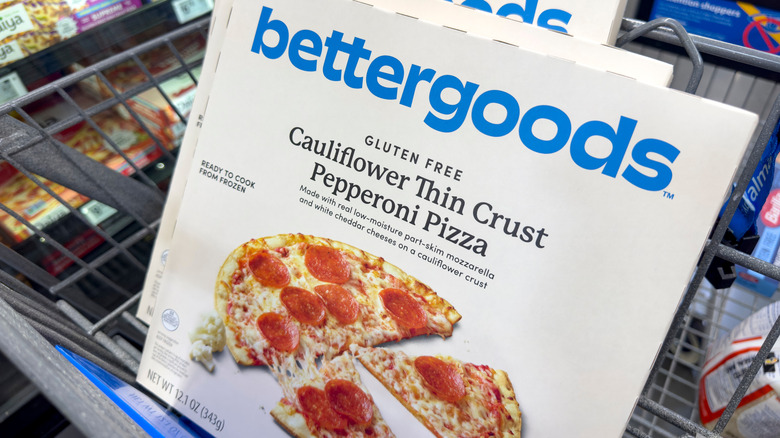The Differences Between Walmart's Great Value And Bettergoods Brands
Walmart is no stranger to private labels, with names like Parent's Choice, Equate, and Marketside only available at one of its over 4,600 stores in the U.S. Perhaps the most popular among the Walmart brands, though, is Great Value. The third brand to be introduced by the company (after Ol' Roy in 1983 and Sam's Choice in 1991), Great Value hit the shelves in 1993 and is recognizable even to those who don't frequent the grocery giant's stores.
Walmart hasn't slowed down on introducing its own product lines either. In spring 2024, the company introduced a new label called bettergoods. With most Walmart labels, it's fairly easy to note the differences between the rest. Ol' Roy is pet-focused, while Parent's Choice revolves around products for the care of babies and young children. However, the introduction of bettergoods may leave a few shoppers confused as to how it's different from labels like Great Value. After all, they both have food that's packaged under their names. Instead of scratching your head in the middle of a grocery aisle, take a look here to learn what the real differences are between Walmart's Great Value and bettergoods brands.
Great Value has a larger product catalog
Perusing the grocery aisles and end caps at Walmart, you'll find food packaging that dons various private and non-private Walmart labels. Among these items will be both bettergoods and Great Value. However, when you move beyond the grocery section and into other areas like home goods or cleaning supplies, you won't find bettergoods on any of the shelves. You will find Great Value, though. This is because the Great Value line extends far beyond food and into other areas, including everything from all-purpose cleaners to light bulbs, whereas the bettergoods name is only associated with food products.
Great Value was introduced to be exactly that — a great value. The primary focus of the brand upon its initiation was providing groceries and household products at a more economical price point. In 2009, Walmart even revamped the Great Value brand to ensure that customers were not only purchasing a lower-cost item, but that the item was also of decent quality. This change could be the reason why some Walmart Great Value foods don't taste like they used to. The Great Value's label appears in over 100 different categories of products, which is likely why it's perhaps the company's most well-known brand.
Bettergoods sticks to food — in a new way
While Great Value has its name plastered in nearly every section of Walmart stores, bettergoods products remain at home in the grocery section. The bettergoods label wasn't introduced to serve the same purpose as Great Value. The bettergoods product line is designed as an additional food brand that's just a little different from anything Walmart has done before. In a company statement, bettergoods was described as "a new, elevated experience that delivers quality, unique, chef-inspired food at an incredible value."
The bettergoods product line is catered to unique or elevated flavors with high-quality ingredients that are accessible at a lower price point. Providing a more diverse snack or meal option without making bettergoods among the most overpriced items at Walmart was the company's ultimate goal. The price point of these items stays under $15, depending on the product. The difference in available food selections between bettergoods and Great Value is clear when searching for a casserole on Walmart's website. Bettergoods comes up with a Sweet Potato with Praline Pecan Casserole, while the same search under the Great Value name provides a box of Cheesy Potato Bake. Each brand serves different shoppers' unique flavor palates.
Differences in packaging and why
Private label packaging is a trend that nearly every grocery store takes part in to sell different products at a lower price point, or products that otherwise might not sell as well in the original packaging. Brands behind Walmart's Great Value include Sara Lee, Land O' Lakes, General Mills, and Ziploc. Maintaining the familiar white and blue Great Value packaging even when the product comes from a different company keeps the customer's mind on associating that product with the low prices they've come to know the Great Value label for.
Stores that take part in this include Target with Good & Gather, Kroger with its Smart Way brand, and even Trader Joe's has a different company behind its grainless granola and other Trader Joe's branded items. The companies that work with Walmart for the bettergoods products aren't known, but the line has already established packaging that customers can associate with the intended reputation of chef-inspired, better ingredients, and lower cost. While customers looking for Great Value are likely trying to cut costs wherever they can, customers who are more focused on saving money but maintaining more flavor and ingredient varieties will likely reach for bettergoods.
Bettergoods is aimed at a unique group of shoppers
Walmart's target demographic is debatable, but the launch of bettergoods is the company's attempt at reaching shoppers that previously may have avoided the store, or at least shopped there begrudgingly. The customers who are most likely to choose bettergoods over Great Value or other brands are those who are likely looking for more natural flavors, a more "adventurous" culinary experience, or have unique dietary restrictions. Sure, there are plenty of health-food grocery chains that cover these needs, but bettergoods aims to maintain a lower price point to meet those needs in a more accessible way.
Bettergoods isn't only inviting to those looking to eat how they want or need without breaking the bank, but it also creates a better experience for those shopping for more than just themselves (which is most people). Instead of making a trip to Walmart for most of your groceries and then needing to drive over to Whole Foods, families or housemates can shop for everyone's different dietary needs. Bettergoods specializes in "made without" products that omit certain ingredients in a product that someone may otherwise not be able to consume.
Bettergoods is intentionally inclusive of a variety of dietary needs
Aside from being chef-inspired at a low price point, bettergoods has other draws that may be even more valuable to a lot of shoppers. The brand's "made without" ideation can mean the item is made without anything from sugar, artificial colors, dairy, gluten, or animal products. Many of the bettergoods items are also plant-based. The private label's packaging makes this clear by proudly displaying the not-included ingredient(s) for consumers to see.
Not only does this take the guesswork out of shopping for those who are used to spending an additional 30 minutes scouring every ingredient list as they do their shopping, but providing these items at a lower price point with clear, to-the-point packaging builds trust in the brand. If a customer eats a gluten-free or plant-based diet and they know the item they're looking for exists at Walmart under the bettergoods brand, chances are they'll make a special trip to Walmart just for that item — and likely leave with a few more items in their shopping carts.
